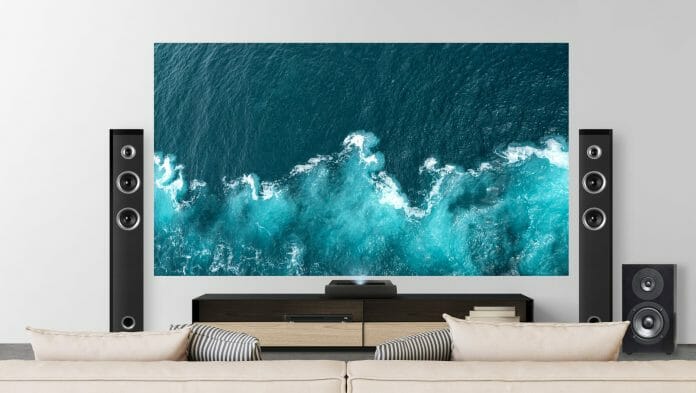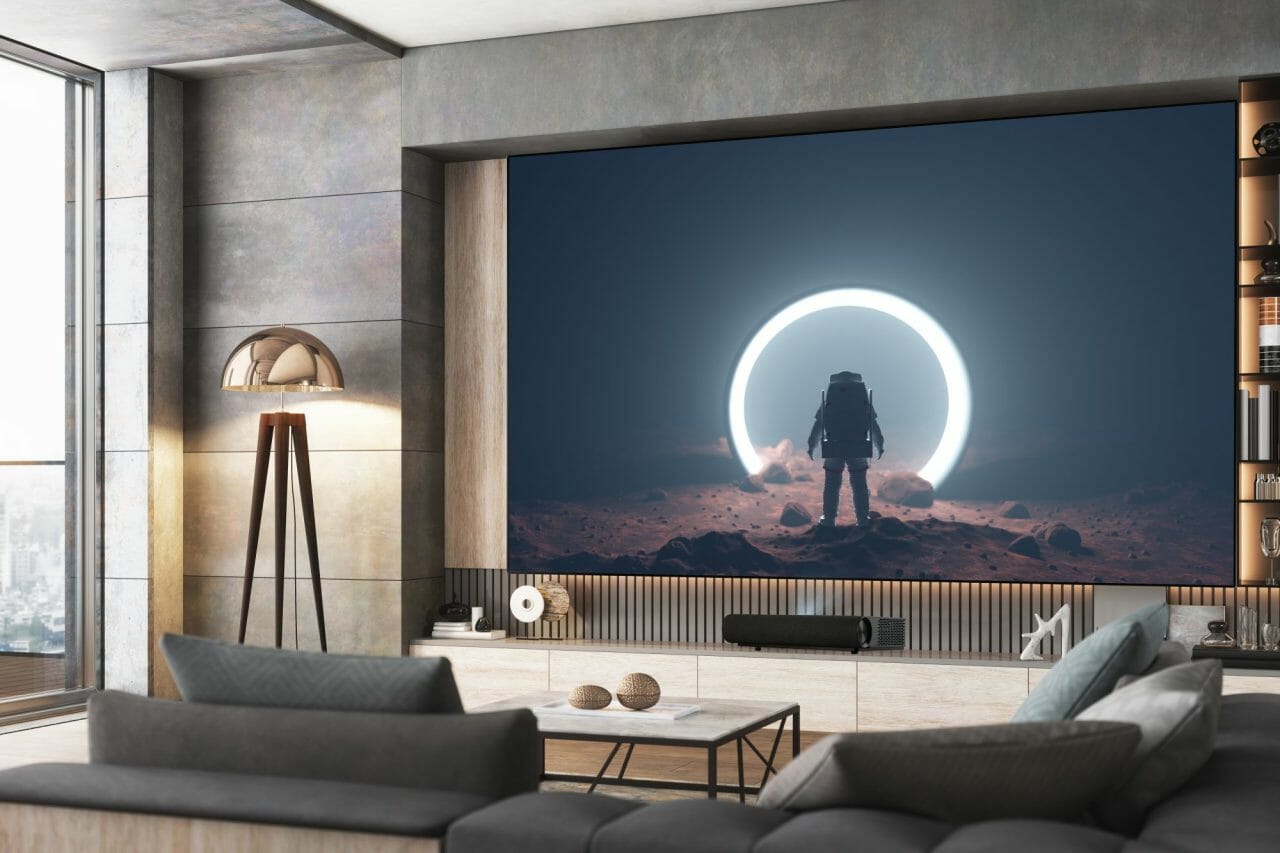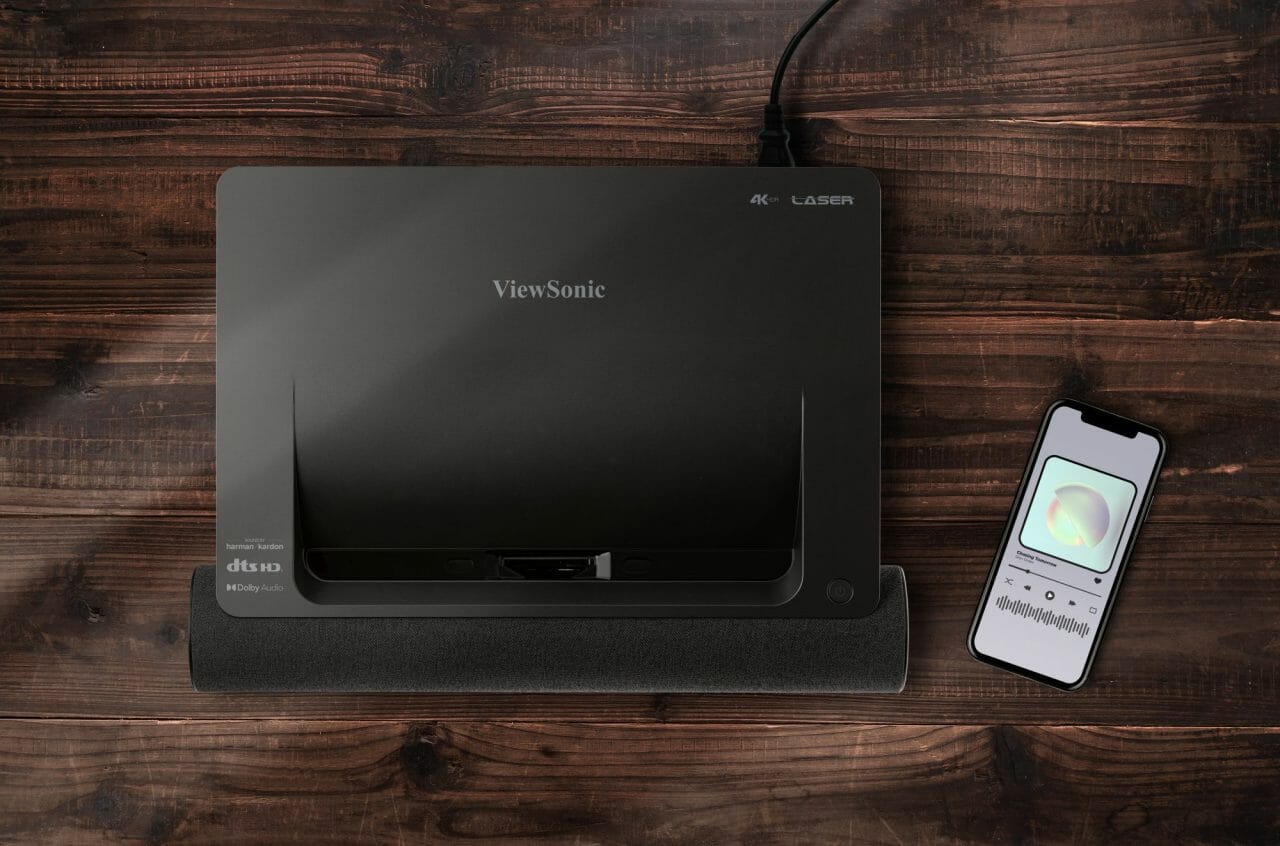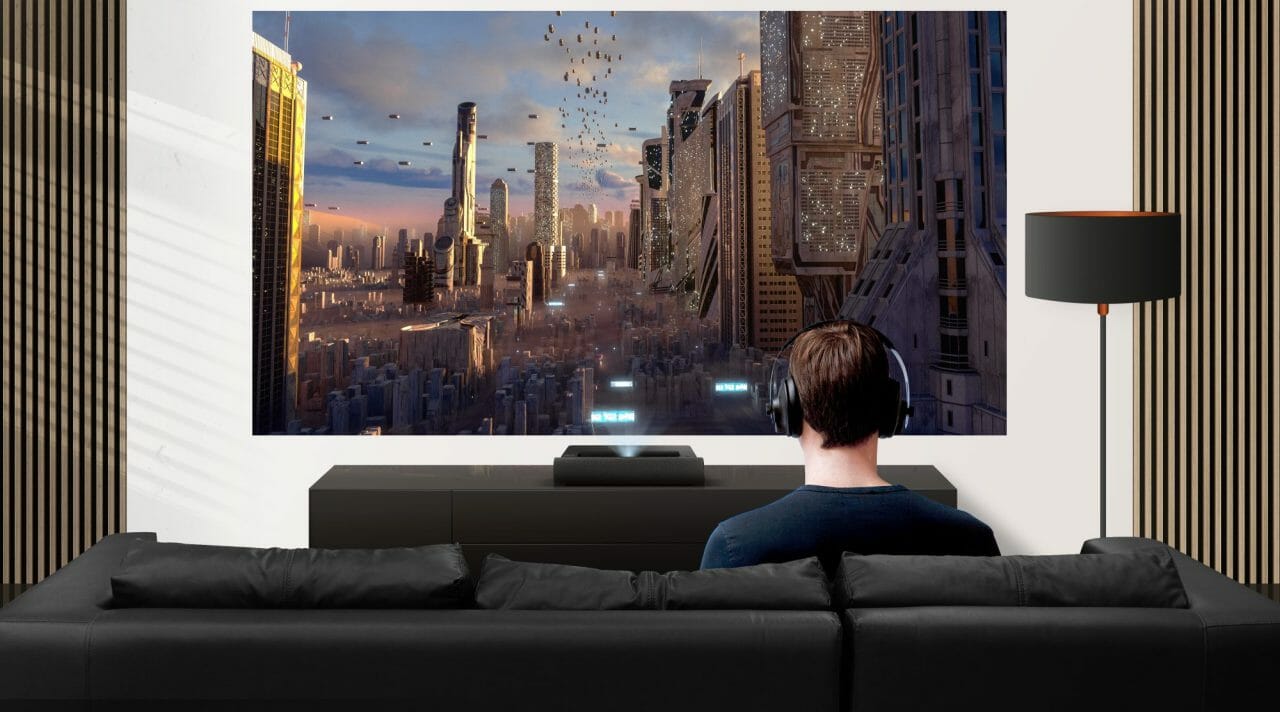ViewSonic is a world-renowned display specialist, and its X2000B-4K ultra-short-throw projector (or UST projector/‘laser TV’ as it’s sometimes referred to) is a good example of how the company puts together a solid product that is designed to do one thing and do it well. Many other displays out there try to be all things to all people; the X2000B-4K is built from the ground up to be the best complement to your home theatre setup… even if it has to do it all on its own.
Which is interesting, since this is ViewSonic’s first-ever such projector, and you would expect there to be teething issues with any first-generation product. And maybe time will bring any such issues to light. In the meantime, however, the X2000B-4K seems to be a solid product. Weighing in at nearly 7kg nett (6.8kg according to ViewSonic), this is pretty light, especially when compared to a 100″ LCD TV, which is what this projector is meant to compete with.
As the name suggests, the X2000B-4K is a projector that uses laser phosphor technology to project at a ‘native’ resolution of 4K (3840×2160) at 60Hz. Coming in two variants (black or white), the X2000B-4K provides that 100 inches of display real estate when positioned approximately 60cm away from the surface you’re projecting it on to (measured from the back of the projector; it’s 23.4cm away if measured from the front). The X2000B-4K comes with a safety feature that cuts power to the lamp if it detects someone is coming too close to it.
Display calibration
The X2000B-4K is a ‘smart laser TV’, which means that rather than simply being a display, it comes with ViewSonic’s own Android-based OS. Hence, the OSD looks more like the full-screen GUI that a smart TV would present to you. By using the included remote control to navigate the menus, the usual brightness, contrast, and other audio/visual settings can be adjusted. Beyond that, the firmware can be updated (yes, the X2000B-4K comes with networking; more on that later), and you can even install streaming apps right into the 32GB onboard storage (26GB usable) from ViewSonic’s app store. Or, if you prefer, install the ViewSonic vCastSender app on your Android device of choice and control it that way.
General work/home usage
As mentioned, the X2000B-4K is meant to be the mainstay of a home entertainment system, and it does so really well. ViewSonic is so confident in this product that the review environment it set up was about as hostile to projectors as it could be; an open indoor space in a shopping mall with lots of bright lighting and ambient noise. Despite that, the image that it projected remained bright with decent contrast and vibrant colours, thanks to the 2000 ANSI lumens of brightness that the projector boasts, and the company’s proprietary Cinema SuperColor™ Technology. The built-in Harman Kardon stereo speakers did not have any discernible audio distortion even at maximum volume – and that volume was pretty impressive for a pair of 25W (10W tweeter + 15W woofer) speakers.
To be sure, this was using the screen that ViewSonic is currently packaging with the X2000B-4K, which presents the projector in the best light, no pun intended. The patented 100″ Fresnel ALR screen rejects ambient lighting from being reflected back to the viewer, presenting a bright display even in broad daylight. And it just works.
That said, this projector is probably best used in the home theatre environment or in an exhibition/conference setting. If you are looking for projectors that are more suitable for use in smaller settings, such as meeting rooms or classrooms, you may be better off with one of the options in ViewSonic’s Business or Education range.
Graphics professionals
While the X2000B-4K does support a wide colour gamut, supporting 100% Rec.709 coverage, projectors aren’t really meant for use in such a setting, except perhaps when exhibiting your finished work. ViewSonic does have its ColorPro® range of monitors that is specifically designed for graphics workloads, although the X2000B-4K is still worth considering once you’re ready to show off those stunning visuals you’ve spent countless hours working on.
Video/gaming performance
Media consumption is where the X2000B-4K really shines, having a few neat party tricks up its sleeve to make it an ideal contender. It even supports 3D content, provided you already have the appropriate 3D glasses.
Aside from supporting HDR and the built-in theatre-quality speakers, the X2000B-4K uses frame interpolation technology to help with reducing motion blur. The projector supports Dolby Digital and DTS surround sound, and features seamless integration with the rest of your home entertainment/hi-fi setup through the HDMI ARC (audio return channel). If you prefer using analogue outputs, the standard 3.5mm headphone jack is included (not necessarily a given these days, especially on smartphones for instance).
As mentioned earlier, the X2000B-4K supports network connectivity through both LAN (Ethernet) and WLAN (Wi-Fi 5), so you can connect it to your home network or NAS and stream your content locally. Bidirectional Bluetooth connectivity is also available (BT4.2), so you can use it as both a receiver (turning it into a Bluetooth soundbar) and a transmitter, sending the audio to Bluetooth earbuds, for instance. Both Android and iOS devices are supported for screen mirroring or casting, so you can watch media on your smartphone through the projector.
One area which did surprise me was the fact that while the X2000B-4K comes with 2 USB Type A ports so that you can plug in an external HDD/SSD or a flash drive and play back media from those, they are USB 2.0 ports. Now, theoretically USB 2.0 can handle 4K content with no issues, but personally I would have preferred to see USB 3 support instead.
As for gaming… well, you could, especially if you’re into console gaming, but even if you’re a casual PC gamer. The X2000B-4K is not meant nor marketed as a gaming projector/display, so it does not feature any of the features you would expect from such a display – the input lag of 40ms is proof enough of that. Your mileage may vary, but console gamers are not likely to be too fussed about the lack of such features, and the X2000B-4K would still deliver a pretty immersive experience with a maximum refresh rate of 120Hz. The noise level is impressive as well, at a very quiet 32dB.
Power consumption
ViewSonic claims that the X2000B-4K draws 250W when operational and <0.5W in standby. Unfortunately, I was unable to verify the power consumption figures, but in my experience, manufacturers tend to overstate rather than understate them.
At RM18,999 with the included screen, or RM16,999 as a standalone, the X2000B-4K is competitively priced against 100″ smart TVs (less than half the price of a QLED display at my local electronics store), and comes with free delivery nationwide and free installation in Peninsular Malaysia and Kota Kinabalu, Sabah. ViewSonic claims a lamp lifespan of approximately 20,000 hours – which is pretty good – coupled with a 3-year onsite warranty; just call ViewSonic’s service centre at 1-800-88-8997 for all service-related enquiries.
For more information, call ViewSonic up at (03) 5036-0468 or via WhatsApp.
By Gregory Kong












